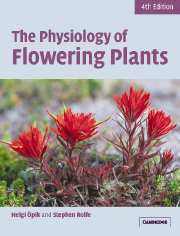Book contents
- Frontmatter
- Contents
- Preface
- Chapter 1 Introduction
- Part I Nutrition and transport
- Part II Growth and development
- Chapter 6 Growth as a quantitative process
- Chapter 7 Plant growth hormones
- Chapter 8 Cell growth and differentiation
- Chapter 9 Vegetative development
- Chapter 10 Photomorphogenesis
- Chapter 11 Reproductive development
- Chapter 12 Growth movements
- Chapter 13 Resistance to stress
- Appendix
- Index
- References
Chapter 13 - Resistance to stress
Published online by Cambridge University Press: 05 June 2012
- Frontmatter
- Contents
- Preface
- Chapter 1 Introduction
- Part I Nutrition and transport
- Part II Growth and development
- Chapter 6 Growth as a quantitative process
- Chapter 7 Plant growth hormones
- Chapter 8 Cell growth and differentiation
- Chapter 9 Vegetative development
- Chapter 10 Photomorphogenesis
- Chapter 11 Reproductive development
- Chapter 12 Growth movements
- Chapter 13 Resistance to stress
- Appendix
- Index
- References
Summary
Introduction
Any factor that acts on an organism so as to impair its functions can be termed a stress. Plants growing in the field are habitually exposed to a number of environmental stresses, e.g. drought and frost. Being sessile organisms, plants cannot move away from a stressful situation. The ability to withstand environmental stresses therefore frequently becomes the limiting factor for plant growth, survival and geographical distribution. Plants in fact may possess remarkable powers of endurance. The vegetation of arctic regions can experience winter temperatures of − 70 ℃, whilst in hot deserts over 50 ℃ may be encountered, and even greater temperature extremes have been survived in the laboratory. On the other hand, some plants are killed by chilling at 10 ℃: species vary tremendously in their resistance towards a particular stress. Studies of the reactions of plants under stress, and mechanisms of stress resistance, are of great practical importance, since agricultural yield is only too often drastically reduced by stressful external factors. The demands of an expanding human population have stimulated research into improving the stress resistance of crop species in order to extend the geographical range of a crop, or with a view to utilizing land areas previously regarded as too ‘extreme’ for cultivation, such as semi-deserts.
Terminology and concepts
Stress is a very wide concept, and while the general idea is easily conveyed it is not so easy to decide where the limits should be drawn. Stress was briefly defined above as ‘impairing function’.
- Type
- Chapter
- Information
- The Physiology of Flowering Plants , pp. 344 - 372Publisher: Cambridge University PressPrint publication year: 2005



